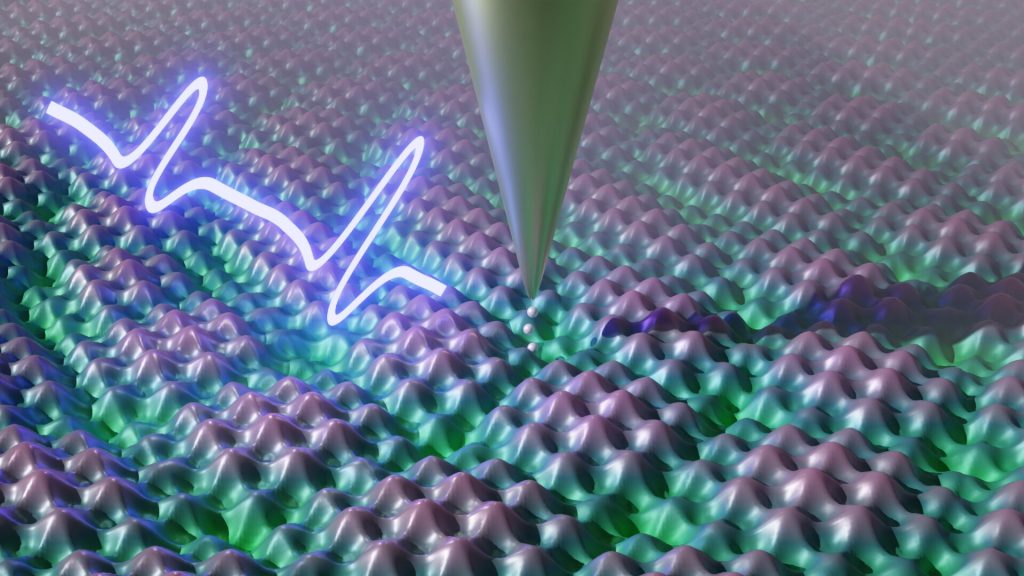The imaging tip of a time-resolved scanning tunneling microscope captures collective electron motion within a material through ultrafast terahertz pulses. Credit: Shaoxiang Sheng, University of Stuttgart (FMQ)
Under the direction of Professor Sebastian Roth, physicists at the University of Stuttgart are developing a quantum microscope that will make it possible for the first time to record the movements of electrons at atomic level with extremely high spatial and temporal resolution.
Their method could enable scientists to develop materials in a much more targeted way than ever before. Published Their findings were Natural Physics.
“Our method allows us to visualize things that nobody has seen before,” says Professor Roth, director of the Institute for Functional Materials and Quantum Technologies (FMQ) at the University of Stuttgart. “This allows us to Movement “We have solved a mystery about electrons in solids that has remained unsolved since the 1980s.” The research results of Ross’s group also have extremely practical implications for the development of new materials.
Small changes have big impacts
With metals, insulators, and semiconductors, the physical world is simple. Atomic levelThe macroscopic properties do not change: for example, a metal modified in this way still conducts electricity, whereas an insulator does not.
But the situation is more Advanced Materialscan only be produced in a laboratory. Minimal changes at the atomic level trigger new macroscopic behaviors. For example, some of these materials suddenly change from insulators to superconductors, conducting electricity without heat loss.
These changes occur very quickly, on the order of picoseconds, because they directly affect the movement of electrons in matter at the atomic level. A picosecond is so short, a trillionth of a second, that it is the same ratio between the blink of an eye and a cycle of over 3,000 years.
Recording the movements of electron swarms
Roth’s research group found a way to observe the behavior of these materials during such tiny changes at the atomic level. Specifically, the scientists studied a material made of the elements niobium and selenium, in which one effect can be observed in a relatively undisturbed way: the collective motion of electrons in a charge density wave.
Roth and his team investigated how a single impurity could stop this collective motion. To this end, the Stuttgart researchers apply a very short electric pulse of just one picosecond to the material. A charge density wave is forced onto the impurity, sending nanometre-sized distortions into the electron population and causing extremely complex electronic motions within the material in a short time.
Key preliminary work for the published findings was carried out at the Max Planck Institute for Solid State Research (MPI FKF) in Stuttgart and the Max Planck Institute for the Structure and Dynamics of Matter (MPSD) in Hamburg, where Roth worked before joining the University of Stuttgart.
Developing materials with desirable properties
“If we can understand how the movement of electron populations is stopped, we can also develop materials with desired properties in a more targeted way,” explains Roth. In other words, since perfect materials without impurities do not exist, the developed microscopy method can help understand how to arrange impurities to achieve desired technological effects.
“Atomistic design directly influences the macroscopic properties of materials,” Roth says. This effect could be harnessed, for example, to create ultrafast switching materials for future sensors and electronic components.
An experiment repeated 41 million times per second
“We already have methods for visualizing individual atoms and their movements,” Roth explains, “but these methods only provide high spatial or high temporal resolution.”
To make the new Stuttgart microscope capable of doing both, the physicist and his team combine a scanning tunneling microscope, which resolves materials at the atomic level, with an ultrafast method of spectroscopy known as pump-probe spectroscopy.
To make the necessary measurements, the lab equipment needs to be very well shielded. Vibrations, noise and air movement are harmful, as are fluctuations in room temperature and humidity. “This is because we are measuring very weak signals that would otherwise easily be lost. Background noise” Ross points out.
What’s more, the team has to repeat these measurements very frequently to get meaningful results: The researchers optimized the microscope to repeat the experiment 41 million times per second, achieving particularly high signal quality. “We’re the only ones who’ve been able to do this until now,” says Loth.
For more information:
Shaoxiang Sheng et al. “Terahertz spectroscopy of collective charge density wave dynamics at the atomic scale” Natural Physics (2024). Publication date: 10.1038/s41567-024-02552-7
Provided by
University of Stuttgart
Quote: Quantum microscopy research makes electrons visible in slow motion (July 16, 2024) Retrieved July 16, 2024 from https://phys.org/news/2024-07-quantum-microscopy-electrons-visible-motion.html
This document is subject to copyright. It may not be reproduced without written permission, except for fair dealing for the purposes of personal study or research. The content is provided for informational purposes only.


